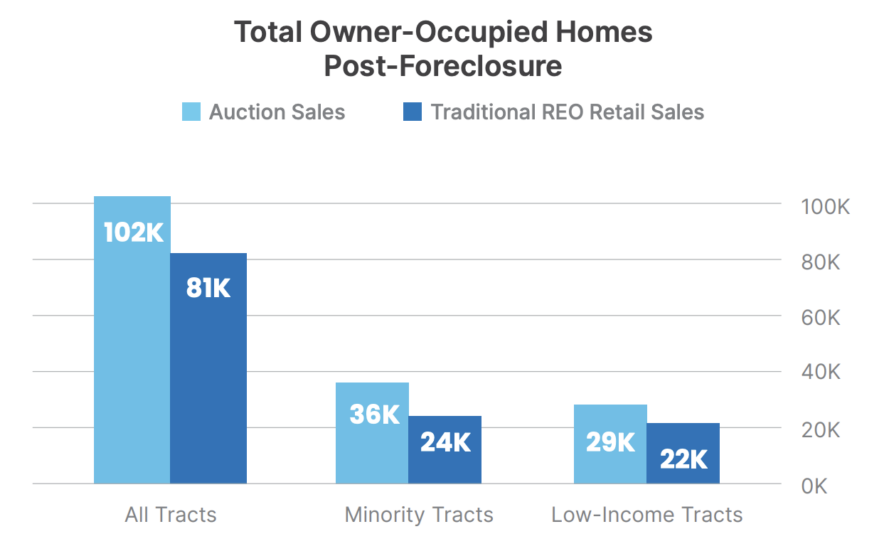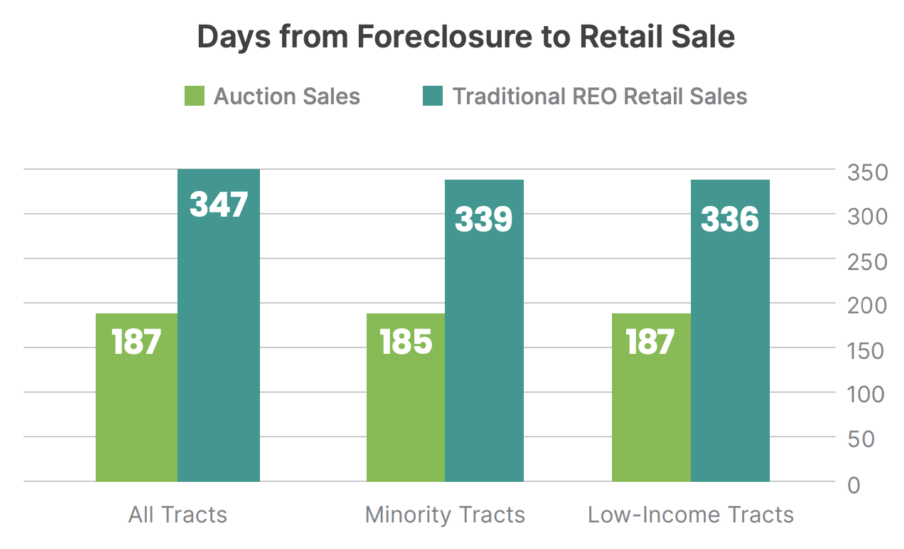According to the first-ever Auction.com 2023 Neighborhood Stabilization Report [1], distressed properties sold on a transparent auction platform produce higher homeownership rates, more value added during renovations, and shorter renovation timelines than distressed properties sold in the traditional retail market.
These trends hold true even in low-income and minority neighborhoods that are often disproportionately impacted by distressed properties. The report also found that more than 180,000 properties foreclosed in the last seven years are now owner-occupied.
"I grew up in a rental home," said Steve, an Auction.com buyer in Chattanooga, Tennessee. "We never owned the home we lived in, so being able to own my home and help other people own homes is a passion of mine."

More than 180,000 Properties Foreclosed in Last Five Years Are Owner-Occupied
An estimated 56% of all properties were brought to foreclosure auction on the Auction.com platform during that period. Approximately 102,000 owner-occupied homes from those sold at auction, some 81,000 from those sold as REO on traditional retail market.
- More than 180,000 properties brought to foreclosure auction on the Auction.com platform in the last five years are now owner-occupied, according to public record tax assessor data. That 180,000 represents 56% of all those brought to foreclosure auction on the Auction.com platform during that period.
- Nearly 102,000 properties sold to third-party buyers at auction are now owner-occupied, representing 57% of the total universe of properties sold to third-party buyers at auction.
- Nearly 81,000 properties that did not sell at auction and subsequently reverted to the foreclosing lender are now owner-occupied, representing 55% of that total population.
Extrapolated to the entire market, this analysis indicates there are nearly half a million (489,000) now owner-occupied homes that were brought to foreclosure auction in the last five years.

Foreclosed Homes Returned to Retail Market Five Months Faster When Sold at Auction
The average time to retail market is about six months for distressed properties sold at auction, compared to more than 11 months for those sold via traditional REO retail sales.
Third-party buyers at distressed property auctions renovated and resold properties in an average of about six months (187 days) after the foreclosure auction, according to an analysis of more than 70,000 properties resold within a year after the auction. That was more than five months faster than the average of 347 days between foreclosure auction and resale for properties that reverted to the foreclosing lender and were then resold as a traditional sale.
Third-party buyers at distressed property auctions returned properties to the retail market consistently faster than traditional REO sales in minority Census tracts and low-income Census tracts. This faster return to retail for auction sales came even with seven times more property value added between the foreclosure auction and retail resale by third-party buyers.
"There is an inherent benefit in having local community developers buying those properties just because we’re smaller so we’re nimbler and we do things faster and everybody wins," said Francois, an Auction.com buyer in Houston.

Renovated Foreclosures Require 23% of Local Family Income to Purchase
Roughly 18% of local family income is required to buy in minority neighborhoods, and some 16% is required in low-income neighborhoods.
Although third-party buyers purchasing at distressed property auction are adding an average of 37 points in property value during renovation, they are still selling the renovated properties at price points that are affordable for local families.
Across all Census tracts, resales of properties purchased by third-party buyers at auction over the last five years sold at an average price of $256,000.
The monthly mortgage payment on those properties, including property taxes and insurance, and assuming a 5% down payment and a 30-year fixed-rate mortgage at the average mortgage rate at the time of purchase, represented 23% of the median family income in the surrounding Census tract.
Renovated Foreclosures Require 22% of Local Family Income to Rent
Renovated homes held as rentals after being purchased at distressed property auctions have estimated rents that are affordable for local families, with those rents representing 22% of the median family income in the surrounding Census tract on average.
Homes were considered to be held as rentals if they were not resold within one year of being purchased at auction. The rent for those homes was based on an automated rental valuation model from a third-party provider.
A March 2023 survey of Auction.com buyers found that 39% of buyers identified renovate-and-rent as their primary investing strategy, while 50% identified renovate-and-resell as their primary investing strategy.
Estimated rents were even more affordable in minority Census tracts, requiring 20% of local family income, and in low-income Census tracts, requiring 19% of local family income.

Good News for Homebuyers Concerned About Housing Affordability
Renovated properties resold or rented by auction buyers are still affordable for local families, including in low-income and minority neighborhoods. The resale homeownership rate is currently 11 points higher for auction than for traditional REO retail sales and remains 12 points higher in minority and low-income neighborhoods.
The homeownership rate for properties renovated and resold after being purchased at auction was 77%, 11 points higher than the 66% homeownership rate for properties sold via traditional sale (REO) by the foreclosing lender.
The homeownership rate for renovated properties purchased at auction was consistently higher than the homeownership rate for traditional REO sales in minority Census tracts (12 points higher) and low-income Census tracts (12 points higher). The lower homeownership rate for traditional REO sales indicates many of those sales are going to investors despite being listed on the multiple listing service (MLS), where owner-occupant buyers are active.
To read the full report, including more data, charts, and methodology, click here [1].
